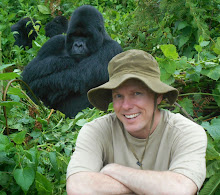
The water in Baptiste Collette Bayou runs south to north below an S in the Mississippi, and the sun can play tricks on one's sense of direction, appearing above the river, even from the east side. We awaken at the north end of Baptiste, just barely offshore, moored to the "floating city", a network of barges in place for the cleanup, anchored a half mile from the jetties at the green 7 and just outside the channel. The "city" contains a crane barge and trash bins for soiled boom, offices and living quarters for about 200 workers who begin to emerge on deck and ignite the day's first cigarettes, the heat already upon us.
We received orders last night, loaded seven pallets of ice in the freezer, more than a thousand bags. We're to run clockwise to SW Pass, off-loading to each of the five task force groups near the entrances to Main Pass, Pass A'loutra, South Pass, and then SW. VHF channel 8 pipes in with "crewboat command" requesting we load more boom; I take my turn at the wheel. I have to bow into a serious current without a bow-thruster, put the boat aside the crane barge. I have to be careful to keep the bow tucked (toward the barge) and the current on the starboard side of the boat. I keep an eye on channel traffic, in case I lose the bow and have to bail. The Mary Jean is a quad-screw, like my regular boat, but the four propellers are aligned differently, set up for an outboard walk. I'm used to doing everything in clutch, but on this older boat that might not work. It does for now and we drift alongside.
Our four workers show up, and its Rick's favorite crew, led by Eduardo; he and Rick are boys, joking and laughing, smoking of course. Three of the four are Mexican immigrants, and today's entertainment will center around the Mexican football effort at the World Cup. With our network of vessels close enough to shore, we use cell phones to contact the work boats, compile coordinates and arrange delivery. At about 07:30, we head ESE into the Gulf.
The deliveries are a simple affair, no cranes or platforms, only shallow water and a constant eye on the depth sounder. We drift as the fishing boats come astern, their framework strung with orange boom in place of net--its soiled and brownish and dripping oil, composing the perennial colored mirror upon a placid surface of sea. Otherwise, there's not much visible oil this close ashore, although I suspect most of the banks and barrier islands are infected.
To the west near shore, a few boats seem to drag net and not boom--they appear to be fishing. Rick talks to one on channel 68, and he says he's "catchin' big, white shrimp". I keep hearing on talk radio about "safe" local seafood, "nose-tested" by inspectors; now I have doubts. The sheen will encroach the furthest at slack tide, but still birds fish the shallows, soaring gulls and fluttering terns and frigates harassing the others. By the end of the day, we've seen maybe a hundred dolphin, apparently smart enough to avoid the oil and stay close to shore--surely fish can't be that smart. On the way back to Baptiste, Mexico is defeated, and the guys are distraught for a spell before smiles return and they're again having a good time. One of them shows me a card trick, his only English words are numbers.
We complete the loop and tie alongside a barge at 18:15. It's steak night at the floating city, and I'm enticed by the warnings of fellow crew on the Mary Jean who insist the dining experience must be akin to that in prison. When Rick and Archie return, Calvin and I hop barges to the mess hall, make our way through a tattooed, rough-looking crowd. The food's not bad for the conditions, high-calorie stuff suited to manual labor. A flat-screen TV projects some nonsense, and the atmosphere purveys amiability through a disparate mix of personality and background.






